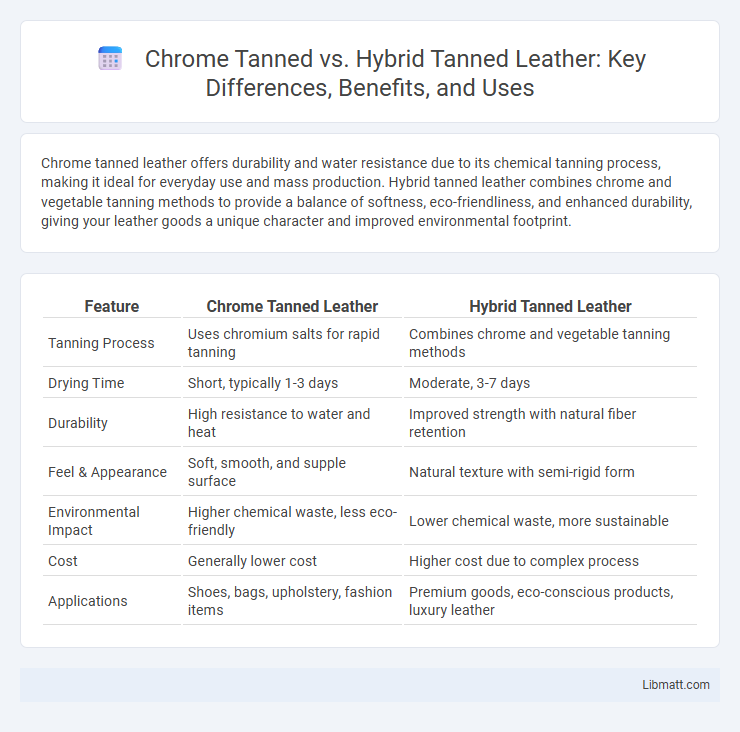Chrome tanned leather offers durability and water resistance due to its chemical tanning process, making it ideal for everyday use and mass production. Hybrid tanned leather combines chrome and vegetable tanning methods to provide a balance of softness, eco-friendliness, and enhanced durability, giving your leather goods a unique character and improved environmental footprint.
Table of Comparison
| Feature | Chrome Tanned Leather | Hybrid Tanned Leather |
|---|---|---|
| Tanning Process | Uses chromium salts for rapid tanning | Combines chrome and vegetable tanning methods |
| Drying Time | Short, typically 1-3 days | Moderate, 3-7 days |
| Durability | High resistance to water and heat | Improved strength with natural fiber retention |
| Feel & Appearance | Soft, smooth, and supple surface | Natural texture with semi-rigid form |
| Environmental Impact | Higher chemical waste, less eco-friendly | Lower chemical waste, more sustainable |
| Cost | Generally lower cost | Higher cost due to complex process |
| Applications | Shoes, bags, upholstery, fashion items | Premium goods, eco-conscious products, luxury leather |
Introduction to Leather Tanning Methods
Chrome tanned leather utilizes chromium salts for rapid tanning, resulting in supple, water-resistant hides favored in fashion and upholstery industries. Hybrid tanned leather combines chrome and vegetable tanning processes to balance durability, eco-friendliness, and aesthetic appeal, often producing a firmer yet flexible product. These tanning methods influence the texture, color retention, and environmental impact of the finished leather goods.
What is Chrome Tanned Leather?
Chrome tanned leather is treated using chromium salts, primarily chromium sulfate, which accelerates the tanning process and enhances leather's durability, flexibility, and resistance to water and heat. This method produces a softer, more pliable leather ideal for fashion items, upholstery, and accessories requiring lightweight yet sturdy material. Your choice of chrome tanned leather ensures quicker production times and vibrant color retention compared to vegetable tanned alternatives.
What is Hybrid Tanned Leather?
Hybrid tanned leather combines chrome and vegetable tanning methods to balance durability and eco-friendliness. This process enhances the leather's softness and moisture resistance while reducing environmental impact compared to traditional chrome tanning. Hybrid tanned leather is ideal for products requiring both strength and sustainability, such as high-quality footwear and accessories.
Key Differences Between Chrome and Hybrid Tanning
Chrome tanned leather uses chromium salts for a faster tanning process, resulting in softer, more water-resistant material with consistent color retention. Hybrid tanned leather combines chrome and vegetable tanning techniques, offering durability and eco-friendliness with a balance of pliability and natural texture. Your choice depends on whether you prioritize quick production and flexibility or an environmentally conscious, robust leather finish.
Chemical Processes Involved
Chrome tanned leather utilizes chromium salts, primarily chromium(III) sulfate, to stabilize the collagen fibers quickly through cross-linking, resulting in a durable, water-resistant material. Hybrid tanned leather combines chrome tanning with vegetable tanning agents like tannins from tree bark, creating a leather that balances softness and firmness by integrating chemical and natural processes. Your choice depends on the desired texture and environmental considerations, as chrome tanning is faster but less eco-friendly compared to hybrid methods.
Durability and Performance Comparison
Chrome tanned leather offers superior durability and resistance to water, heat, and wear, making it ideal for everyday use and products requiring long-lasting performance. Hybrid tanned leather combines chrome tanning with vegetable tanning, enhancing its toughness while maintaining a more natural aesthetic and increased breathability. This combination results in leather that balances durability with improved flexibility and a unique texture, outperforming purely vegetable-tanned leather in both resilience and comfort.
Environmental Impact: Chrome vs Hybrid
Chrome tanned leather involves the use of chromium salts, which can lead to environmental concerns such as water pollution and difficulty in waste management due to toxic heavy metals. Hybrid tanned leather combines chrome tanning with vegetable tanning, reducing chromium usage and thereby lowering the environmental footprint by minimizing hazardous waste and enhancing biodegradability. This balanced approach offers improved sustainability compared to conventional chrome tanning while maintaining the durability and flexibility of leather.
Applications and Common Uses
Chrome tanned leather is widely used in fashion accessories, upholstery, and automotive interiors due to its softness, flexibility, and water resistance. Hybrid tanned leather, combining vegetable and chrome tanning methods, offers enhanced durability and aesthetic appeal, making it ideal for high-end footwear, luxury bags, and premium furniture. Both types serve distinct markets, with chrome tanned leather favored for mass production and hybrid tanned leather preferred for artisanal, durable, and eco-conscious products.
Care and Maintenance Tips
Chrome tanned leather requires regular cleaning with a damp cloth and conditioning with a specialized leather conditioner to maintain its softness and prevent cracking. Hybrid tanned leather, combining chrome and vegetable tanning methods, benefits from gentle cleaning and periodic conditioning to preserve its durability and natural finish. You should store both types in a cool, dry place away from direct sunlight to avoid discoloration and drying out.
Choosing the Right Leather for Your Needs
Chrome tanned leather offers superior water resistance and quick production times, making it ideal for durable, everyday items like bags and shoes. Hybrid tanned leather combines chrome and vegetable tanning methods to balance durability with enhanced aesthetic appeal, providing a softer, more natural feel suited for luxury goods. Your choice depends on whether you prioritize fast processing and resilience (chrome tanned) or enriched texture and eco-friendliness (hybrid tanned).
Chrome tanned vs hybrid tanned leather Infographic

 libmatt.com
libmatt.com